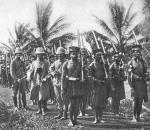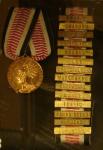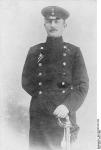-
Posts
190 -
Joined
-
Last visited
-
Days Won
1
Content Type
Profiles
Forums
Blogs
Gallery
Events
Store
Everything posted by Chris Dale
-
Good question. Here's Rick Researches answer to a similar question (I hope he won't mind me quoting him from the Wehrmacht Awards Forum http://www.wehrmacht...ead.php?t=26723 ). "The M1913 IX years service medal on the right was given only to enlisted ranks. When found in an officer's or official's group, such an award indicates service up from the ranks. Typically, Feuerwerks, Veterinary etc officers spent long years as NCOs before being commissioned, and in such cases they continued to wear their enlisted long service awards, but these were not made TO officers." I've seen examples of Bavarian, Saxon, Wurttemberg and Hessian long service awards. Does anyone know which states did and which did not have their own awards? Cheers Chris
-
Are you certain on that? One morning I was curious to find pubic hair on my computer keyboard. No, it wasn't what you're all thinking ... but I was mystified. After some thought and chin rubbing, I realised I often rub my chin when in thought and odd hairs from my beard had fallen onto the keyboard! The moral of this story is that pubic and beardy hair can be quite similar.... Cheers Chris
-
Hello Cladius, Stallmeister is Equerry in English. Wikipedia defines an equerry as "Historically, it was a senior attendant with responsibilities for the horses of a person of rank. In contemporary use, it is a personal attendant, usually upon a Sovereign, a member of a Royal Family, or a national representative." but specifically in Germany its meaning was still the historical version "In medieval and modern Germany, a stallmeister (literally, "stable master") or hofstallmeister ("court stable master") was one of the highest noble officials in a princely or royal court, responsible for the supervision of the manorial stables. The stable servants were subordinate to him. Out of this rank developed the office of marshal. In present parlance, stallmeister means Stable Master." So its the Stable Master to the Prince of Ruess. See http://de.wikipedia....ki/Stallmeister and http://en.wikipedia.org/wiki/Equerry Hope that helps, Cheers Chris
-
Thank you Deruelle and Saschaw for your very helpful answers so far. So a Reserve Officer got his Long Service award after 20 years, but a regular army officer got his after 25 years. Is that correct? But was anyone still an EM after 9 years service? Surely any soldier would be an NCO by then? Or are there examples of EM ranks with the Long Service award? Cheers Chris
-
Hello Learned Gentlemen, This might seem an obvious question to some of you but were Prussian Long Service Medals 1st-3rd Class only for NCOs? Would any private soldiers still be serving after 9 years without promotion to NCO status? Officers would only get the 25 Year Officer's Long Service Cross, wouldn't they? If those last two are correct, then only NCOs would have the 1st-3rd Class Long Service awards surely? Or am I missing some key clues? Any help would be appreciated... Cheers Chris
-
I've added a couple more interesting medal bars to that page- http://www.sacktrick.com/igu/germancolonialuniforms/militaria/medalbarscolonial.htm I've also written a new page on the types of medals seen in the colonies and ob German overseas troops at- http://www.sacktrick.com/igu/germancolonialuniforms/militaria/medals.htm Much of these updates have only been possible with the generous help of some of you Gentlemen at this forum. Thank you very much. If anyone spots any mistakes or omissions on my website, or if anyone else has any medals and bars they'd like to see added please let me know. All the best for a Happy New Year, Cheers Chris
-
And here's a photo of Paul Lambert Werber taken in Ponape. From left to right the three German officers are Otto Erhard, Edgar Spiegel von und zu Peckelsheim and Paul Lambert Werber. This photo is the front cover of Morlang's aforementioned book. The same photo can also be seen along with other Sokehs Rebellion pictures at http://www.micsem.org/photos/sokehs/thumbs.htm Cheers Chris
-
How about 14? I believe that's the whole collection with the exceptions of the Kalahari 1907 and 1908 clasps, isn't it? It's on display at the Imperial War Museum. Of course it seems unlikely it was issued to one soldier and is probably a compilation of people's medals. Nice to see them together though... Cheers Chris
-
From what I've read the DSWA and China non-combatant medals were awarded to personell aiding the war effort back home. I love this quote from Paul C on this forum... So someone like training staff, supply and depot people or ships crews might get it? Then be called up for combat service when it was "all hands on deck" for the First World War... does that sound plausible? Cheers Chris
-
Yes Beamte, I agree... I'd say..... First World War service in non-combatant role (from EK2 n-c and War Aid Cross), officer rank (from Red Eagle), doctor (Red Cross Medal), served in Finland in 1918 possibly alongside Swedish volunteers (Finnish and Swedish medals). Does that sound right? Cheers Chris
-
Thanks, that would explain most of the awards I'd seen being First World War era. I guess that also applied to colonial wars? Here's a photo of Paul von Lettow Vorbeck in 1904 not long before he served in the Herero War. So his ribbon must be for an award during the Boxer War. Does that sound right? And what award could it be? The photo is from Bundesarchiv / Wiki Commons- http://commons.wikimedia.org/wiki/File:Bundesarchiv_Bild_183-2007-0621-500,_Paul_Emil_von_Lettow-Vorbeck.jpg Cheers Chris
-
Thanks for that Saschaw. That explains why I've never seen a campaign or long service award worn there. Does anyone know what other Prussian awards could be worn there? As some photographs look like they've got an EK2 but they're pre-1914... I'm thinking they could be something like the KVM or Crown Order on the same ribbon as an EK2? Is that possible? Great sale going on, Saschaw!!! I wsh I had a bit more money lying around right now, you've got bargains up there. Cheers Chris





